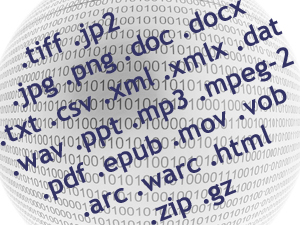File Formats Assessments: Difference between revisions
Jump to navigation
Jump to search
AkikoKimura (talk | contribs) mNo edit summary |
AkikoKimura (talk | contribs) mNo edit summary |
||
| Line 7: | Line 7: | ||
Feedback is always welcome. If you have any comments or suggestions, please email: [mailto:digitalpreservation@bl.uk DPT] | Feedback is always welcome. If you have any comments or suggestions, please email: [mailto:digitalpreservation@bl.uk DPT] | ||
|style="vertical-align:top;"|[[File:BL Logo (Big).jpg|40px]] | |style="width:60px; vertical-align:top; text-align:right;"|[[File:BL Logo (Big).jpg|40px]] | ||
|} | |} | ||
Revision as of 11:15, 17 March 2015

|
File formats are a means of structuring information in a sensible way for storage, retrieval and use. There are a wealth of different formats supporting a range of data types, from specific instances to container formats able to store different types of data.
The Digital Preservation Team at the British Library has undertaken file format assessments to capture knowledge about the gaps in current best practice, understanding and capability in working with specific file formats. The focus of each assessment is on capturing evidence-based preservation risks and the implications of institutional obsolescence which lead to problems maintaining the content over time. Feedback is always welcome. If you have any comments or suggestions, please email: DPT |
Assessment Criteria
See the format assessment factors covered in each assessment.
Preservation Risk Assessments by Format Type
IMAGE
| File:Icon TIFF 200 ComingSoon.jpg |
DOCUMENT